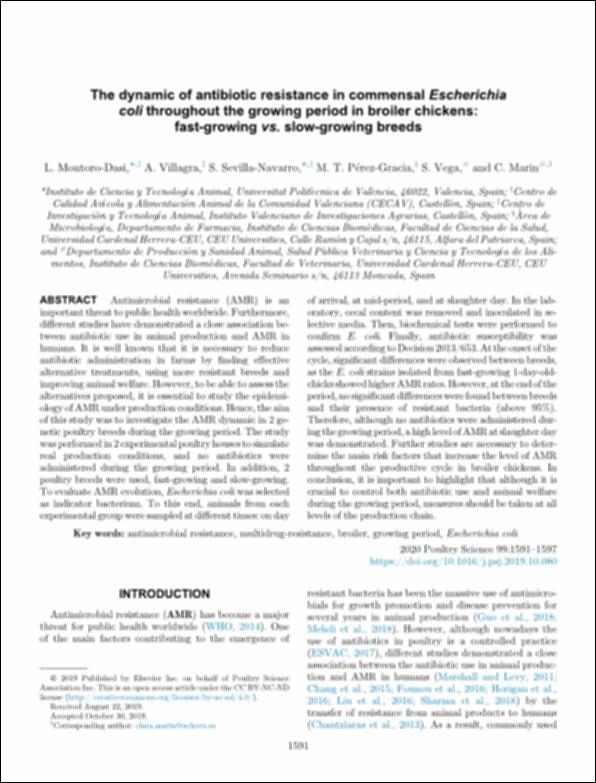Por favor, use este identificador para citar o enlazar este ítem:
http://hdl.handle.net/10637/12743The dynamic of antibiotic resistance in commensal "Escherichia coli" throughout the growing period in broiler chickens : fast-growing vs. slow-growing breeds
| Título : | The dynamic of antibiotic resistance in commensal "Escherichia coli" throughout the growing period in broiler chickens : fast-growing vs. slow-growing breeds |
| Autor : | Montoro Dasí, Laura Villagrá García, Aránzazu Sevilla Navarro, Sandra Pérez Gracia, María Teresa. Vega García, Santiago Marín Orenga, Clara |
| Materias: | Vibriosis - España - Comunidad Valenciana.; Vibriosis - Spain - Valencia (Autonomous Community).; Gram-Negative Bacteria - Spain - Valencia (Autonomous Community).; Drug resistance in microorganisms.; Aves de corral - Enfermedades infecciosas - España - Comunidad Valenciana.; Poultry - Communicable diseases - Spain - Valencia (Autonomous Community).; Bacterias - Resistencia a los medicamentos.; Bacterias Gram-Negativas - España - Comunidad Valenciana. |
| Editorial : | Elsevier |
| Citación : | Montoro-Dasi, L., Villagra, A., Sevilla-Navarro, S., Pérez-Gracia, M.T., Vega, S. & Marin, C. (2020). The dynamic of antibiotic resistance in commensal "Escherichia coli" throughout the growing period in broiler chickens : fast-growing vs. slow-growing breeds. Poultry Science, vol. 99, n. 3 (01 mar.), pp. 1591-1597. DOI: https://doi.org/10.1016/j.psj.2019.10.080 |
| Resumen : | Antimicrobial resistance (AMR) is an important threat to public health worldwide. Furthermore, different studies have demonstrated a close association between antibiotic use in animal production and AMR in humans. It is well known that it is necessary to reduce antibiotic administration in farms by finding effective alternative treatments, using more resistant breeds and improving animal welfare.However, to be able to assess the alternatives proposed, it is essential to study the epidemiology ofAMRunder production conditions.Hence, the aim of this study was to investigate the AMR dynamic in 2 genetic poultry breeds during the growing period. The study was performed in 2 experimental poultry houses to simulate real production conditions, and no antibiotics were administered during the growing period. In addition, 2 poultry breeds were used, fast-growing and slow-growing. To evaluate AMR evolution, Escherichia coli was selected as indicator bacterium. To this end, animals from each experimental groupwere sampled at different times: on day of arrival, at mid-period, and at slaughter day. In the laboratory, cecal content was removed and inoculated in selective media. Then, biochemical tests were performed to confirm E. coli. Finally, antibiotic susceptibility was assessed according toDecision 2013/653.At the onset of the cycle, significant differences were observed between breeds, as the E. coli strains isolated from fast-growing 1-day-oldchicks showed higherAMRrates.However, at the end of the period, no significant differences were found between breeds and their presence of resistant bacteria (above 95%). Therefore, although no antibiotics were administered during the growing period, a high level ofAMRat slaughter day was demonstrated. Further studies are necessary to determine the main risk factors that increase the level of AMR throughout the productive cycle in broiler chickens. In conclusion, it is important to highlight that although it is crucial to control both antibiotic use and animal welfare during the growing period, measures should be taken at all levels of the production chain. |
| Descripción : | Este artículo se encuentra disponible en la siguiente URL: https://www.sciencedirect.com/science/article/pii/S0032579119578105 |
| URI : | http://hdl.handle.net/10637/12743 |
| Derechos: | http://creativecommons.org/licenses/by-nc-nd/4.0/deed.es |
| ISSN : | 0032-5791. 1525-3171 (Electrónico). |
| Fecha de publicación : | 1-mar-2020 |
| Centro : | Universidad Cardenal Herrera-CEU |
| Aparece en las colecciones: | Dpto. Producción y Sanidad Animal, Salud Pública Veterinaria y Ciencia y Tecnología de los Alimentos |
Los ítems de DSpace están protegidos por copyright, con todos los derechos reservados, a menos que se indique lo contrario.


